By 1993, the Disney Animation department was finally—finally—flying high. The Little Mermaid, Beauty and the Beast, and Aladdin had all been solid hits, leading to talk of a “Disney Renaissance,” a term that would later be used to include all of the films from The Little Mermaid to Tarzan, or, for some Disney scholars, all of the films from The Great Mouse Detective to Fantasia 2000 except Oliver and Company. The Rescuers Down Under, if not exactly a hit, had at least allowed animators to develop and play with computer software that allowed for stunning new animated techniques, now being used for the finishing touches on a movie about a little lion that, ok, was just filler until the real prestige movie, Pocahontas, could be completed.
Still, the opening segment of that filler movie—a little scene involving a bird’s eye view of animals running across an African safari—and the sheer beauty of the initial background work and some of the storyboards for Pocahontas started giving directors Gary Trousdale and Alan Wise ideas. Their film, Beauty and the Beast, had often taken a serious approach, in between the sillier moments featuring a singing candlestick and a chipped tea cup, and been lauded as high art. What if they were to follow that success with another high concept, serious film—like, say, an animated adaptation of Victor Hugo’s Notre-Dame de Paris?
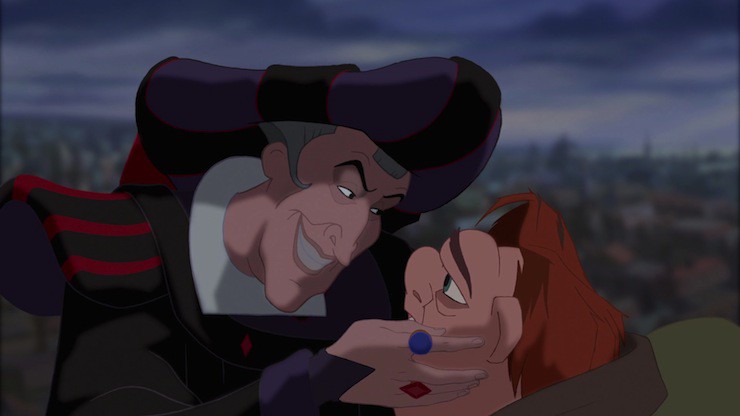
The choice was perhaps not entirely out of left field. The book had, after all, been made into a number of more or less successful film and television adaptations before this. More recently, the musical version of Victor Hugo’s Les Miserables, which had premiered in Paris in 1980 and in London in 1985, had become a global sensation, translated into multiple languages and becoming one of the longest running West End and Broadway productions of all time (although that little tidbit wasn’t yet known when the Disney film was in development). Since many of Disney’s animated films were, for all intents and purposes, Broadway musicals, a happy version of Hunchback of Notre Dame may have seemed a natural match.
At the same time, it was entirely out of left field, since Notre-Dame de Paris is emphatically not a story for children. Disney had, certainly, adapted some not particularly for children, or at least not young children, material before this—Bambi, The Fox and the Hound, and Who Framed Roger Rabbit all leap to mind. But none of these necessarily boded well for a child friendly Hunchback adaptation. Who Framed Roger Rabbit was an oddity for the studio, a live action/cartoon feature released with a PG rating (and partly a Spielberg production); The Fox and the Hound had to be completely overhauled to the point where it barely resembled the original novel; and Bambi, less overhauled, had left many small children in tears, when not completely traumatized.
And of all of these, Notre-Dame de Paris was perhaps the least suitable source for a children’s film, quite apart from the book’s length, what with the high death toll, multiple scenes of violence, a plot largely motivated by sexual obsession (not really a typical Disney theme), two people almost having sex right in front of a priest, and ongoing digressions about architecture, completely unsuited for animation.
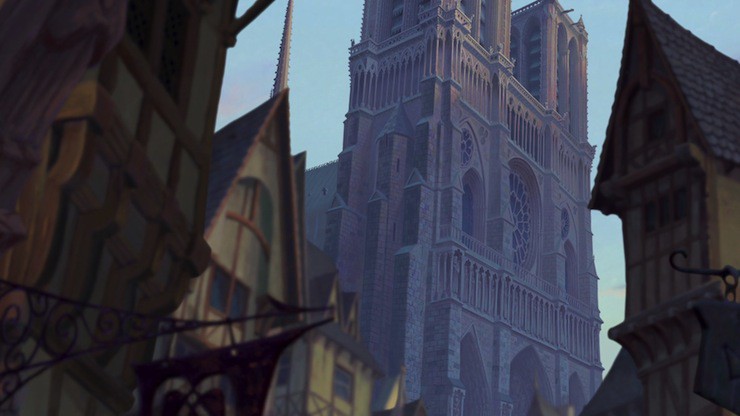
The studio could, of course, have tossed all of this, instead creating something like a second Oliver and Company—an amusing story, possibly focused on an ugly hunchback and the adorable goat he befriends—with almost no connection to the original apart from the name. But for whatever reason, perhaps a respect for the original, or perhaps too many conversations about how the 1939 version with Maureen O’Hara got it “wrong,” the animators avoided this. The animators also had the option to simply jettison any hope of a G rating, and instead plan the film for a PG rating, aiming it at a slightly older audience, as Disney had with The Black Cauldron. But here, directors ran straight into an insurmountable obstacle: Disney executives who well remembered the box office disaster that had been The Black Cauldron (a memory they were only finally able to overcome six years later, when approving Treasure Planet), and who demanded that the film retain its G rating.
It did, if only by severely stretching the definition of that G rating, and by making last minute changes to one scene—Frollo’s fantasy of Esmeralda dancing in the flames—after the MPAA raised numerous objections to images that suggested that Esmeralda was not wearing enough, or indeed any, clothing during that dance. That’s the sort of thing which might be expected to happen to any woman who decides to dance in the middle of a fire, but the MPAA was less sympathetic on this point, insisting that the scene suggested enough nudity to require at least a PG-13 rating. Animators managed to change the scene just before release.
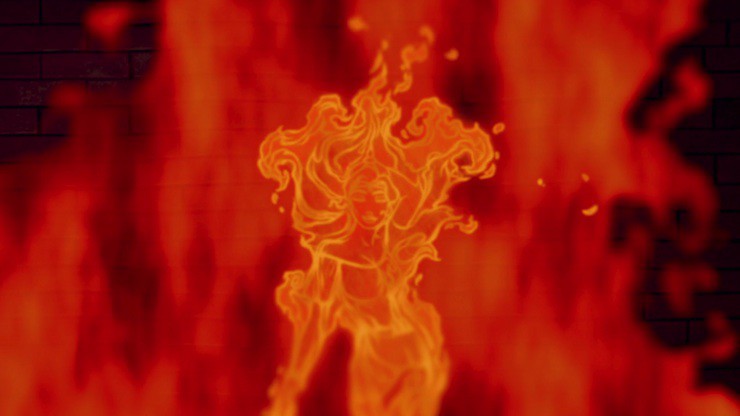
But very adult themes, including infanticide, sexual obsession, and religious obsession remained, creating an animated film with extensive, uncartoonlike violence: a woman killed in the first few minutes of the film; a family almost burned alive; a mob scene involving several soldiers and citizens hit by weapons and flying stones; and most of Paris set on fire. One of the film’s centerpiece songs, “Hellfire,” features terrifying demons and a seductive, sensuous dance. It’s one of only a very few sequences in Disney animated films to feature demons (the others are Fantasia’s “Night on Bald Mountain,” and a few bits coming up in The Princess and the Frog), and it may be the most terrifying of the three. The center romance is a love triangle, without any villains, one that does not go all that well for the main protagonist. And all of the characters, except for one or two cameo appearances from children, are definitely adults. Not young adults, as in other Disney films, but adults.
The result was an oddity in the Disney animated canon: an animated film marketed to children that does not necessarily feel that it’s for children. It’s also one of the darkest of Disney films, if not the darkest: The Black Cauldron, after all, featured monsters, not real people committing atrocities in the name of religion and justice; Bambi’s mother was shot offscreen, not killed on screen in the first six minutes of the film. The closest thematically to this is either Fantasia’s “Night on Bald Mountain” or Pinocchio. And none of these films had dealt directly with the issues of religion and sexual obsession.
This may help explain why, at some point during development, the producers decided to add three gargoyles to the film as comic relief. Partly, of course, the gargoyles were intended as toys (a promotional tie-in with Burger King did, in fact, sell them as toys), and they may also have been inspired by Gargoyles, the Disney cartoon which was airing as Hunchback was developed and animated. And, by the time Hunchback came around, it was almost impossible to conceive of a Disney film without a comedic sidekick, generally voiced by a famous comedian—in this case, Jason Alexander, then on Seinfeld, but also hired for his previous voice work and Broadway experience.
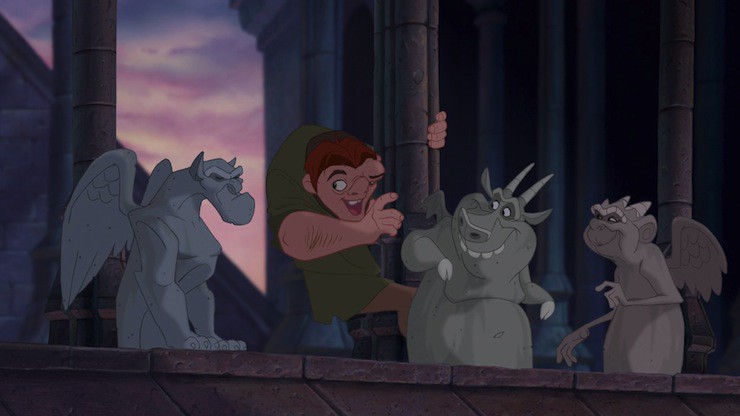
Adding comedy to darker material was, of course, hardly a new development—think of the gravedigger scene in Hamlet. But in this case, it’s an uneasy fit, perhaps best exemplified by the complete tonal dissonance of a scene relatively late in the film, when Frollo’s order to burn down Paris is immediately followed by the gargoyles breaking out into the big, cheerful Broadway number “A Guy Like You,” complete with dancing. To be clear, they’re singing about Quasimodo, not Frollo, and the song is mostly meant to showcase Jason Alexander’s very real Broadway talents, and in that sense it works, but the timing is beyond wrong: Paris is burning, Phoebus is badly injured, Esmeralda could be killed at any moment—and the gargoyles choose this moment to start tap dancing.
Ok then.
Ok, yes, the gargoyles are made of stone, which explains things—except that in other scenes, the gargoyles are depicted as (mostly) kind, caring individuals, and it seems incredible that they would have no interest in the tiny little fact that the city is burning up beneath them. Adding to the problem: the song encourages Quasimodo to think that he has an actual shot at Esmeralda, a hope that is immediately COMPLETELY CRUSHED by the VERY NEXT SCENE where Esmeralda and Phoebus end up making out right in front of him, leading to the tragic destruction of an innocent playing card and a crying Quasimodo, like, thanks, gargoyles, for giving him all that false hope.
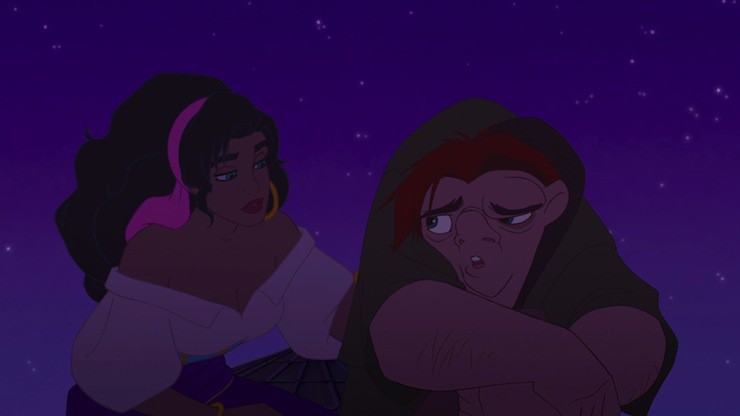
Nor does it help that the film seems unsure about the exact status of the gargoyles. They turn into unmoving stone whenever anyone other than Quasimodo is around, and at one point, Quasimodo admits, in the dialogue, that the gargoyles are just stone, implying that their movement and conversation only exist in his imagination. In later scenes we see them having difficulty with affecting real objects other than the toys Quasimodo has created, or playing cards: they have problems helping Quasimodo move both Phoebus and Esmeralda, and are helpless to help Quasmiodo against Frollo. And yet, in later scenes, we see them throwing stones that knock out and injure the oncoming soldiers.
Speaking of which, remember when the major point of Notre-Dame de Paris was to convince people that the Cathedral of Notre Dame needed to be protected and preserved in all its glorious beauty as the greatest expression of human thought and achievement in Paris? And then remember the way in this film Hugo the gargoyle then cheers on the idea of BREAKING OFF BITS OF CAREFULLY CARVED STONE FROM THE CATHEDRAL TO USE THOSE STONES AS WEAPONS?
Er.
Yes, that’s all done in defense of the cathedral, but it’s still the single most jarring change from the book, made all the more jarring thanks to the one earlier scene that does focus on Notre Dame’s beauty, suggesting that it—and God—can defend the helpless. If bits of it are torn apart and used as weapons, AUUUGH.
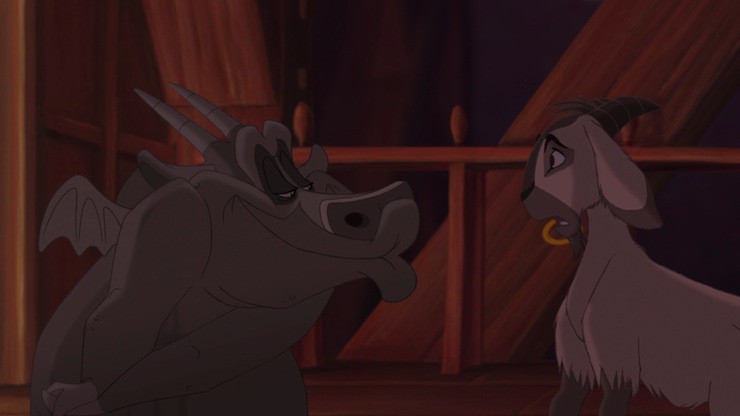
Having said all this, I must give the gargoyles credit for one thing: they’re responsible for one of Disney’s hands down best getting-crap-past-the-radar moment in any of their animated films, one I will admit I missed the first time around, when the very male Hugo falls in love—ok, in lust—with a goat. A male goat. A goat referred to, more than once, as a male. This is hardly the first or last time a Disney sidekick character has fallen hard for another Disney sidekick character (it’s almost a subplot of the film that follows this one), but it is the first time in a Disney animated film that a guy has fallen for a guy. Ok, sure, yes, Hugo is made of stone, and the goat is, well, a goat, but let’s take progress where we can get it. It’s also a nice nod to the book, where the very male poet Pierre Gringoire had had a similar—if not quite as lustful—reaction to the same goat.
And to be fair, here and there the film has a few nice nods to the book, suggesting that someone associated with the film did read it: for example, Phoebus’s complaint that Paris is always changing, meaning that he can never find his way around it, very close to a complaint made by a character, or more specifically Victor Hugo complaining through a character in the book. But for the most part, the film is more striking for the ways in which it changed certain elements of the book—while keeping the focus on sexual obsession and the many men who fall for Esmeralda.
For instance, religion. Victor Hugo’s primary interest had been in Notre Dame’s architecture, not its religious practices. His secondary interest was in portraying the hypocrisy of certain church officials, in the process displaying a certain cynicism about religion. In his novel, Frollo is as intrigued by alchemy as by God; his austerity comes as much from his studies, his personality, and his desire to provide for his rather useless brother as it does from anything found in the Bible. In the film, Frollo, changed from archdeacon to judge, is far more focused on religion and god, and the archdeacon (in the film a separate character) seems, in his very brief appearances, to be a genuinely good and holy man, though I have to question why, if this is indeed the case, the archdeacon seems to have left so much of Quasimodo’s life and upbringing up to Frollo, given that the archdeacon is perfectly aware of exactly what Frollo is: someone who has murdered in the cause of enforcing order.

But the main religious moments center not on the archdeacon, but Esmeralda, singing “God Help the Outcasts,” as she wanders through Notre Dame, a hymn that both invokes God and decries racism and cruelty to people who, well, look different, like Quasimodo, which includes lingering looks at the religious images of Notre Dame. The song is usually read as a plea for tolerance towards minority viewpoints (and by some more cynical viewpoints, as the animation department’s way of responding to the various threats by U.S. religious rights organizations to organize boycotts of Disney, although the actual boycott, led by the Southern Baptist Convention, was not announced until the film was released). It’s not just one of the very few outright religious statements found in Disney animated films, which mostly avoid any discussion of religion whatsoever, but it’s in sharp contrast to the religious cynicism seen in the book.
The greatest change made to the book, however, was the ending, where instead of dying by hanging, and sharing a grave with Quasimodo, Esmeralda lives—and marries, not the ugly hunchback who saved her life and did Tarzan swings across crowds and smoke and fire for her, but the good looking Phoebus.
I don’t know that I could have expected more from the directors—who had, after all, ended Beauty and the Beast by transforming the Beast into a handsome prince (a moment later mocked in Shrek), even if that moment followed the fairy tale, and who were, after all, more or less working from a novel where Esmeralda did fall in love with Phoebus largely thanks to his looks, and later rejected Frollo in part because he wasn’t as good-looking as Phoebus. In that sense, the ending works as another nod to the original novel. I also have to applaud the film for letting Quasimodo accept Esmeralda’s choice with only a touch of jealousy and sullenness. This may be a film that treats its only major woman character as a sex object, with a villain that sings about how his sexual attraction to Esmeralda is destroying him, but it at least accepts, without question, that Esmeralda has the right to make her own choices, and does not look down on her for doing so. (In this one small way, it’s slightly better than the book.)
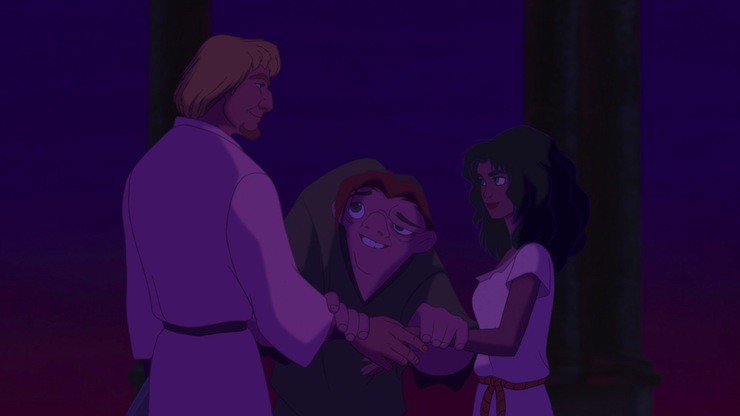
And, objectively speaking, Phoebus is probably a better match for Esmeralda in many ways than the shy, extremely sheltered Quasimodo, who, for the most part, has only seen the world from the top of the bell towers of Notre Dame. As I noted, he barely even seems to have spoken to the kindly archdeacon, who probably would have countered at least some of Frollo’s harsh words. Phoebus has travelled a lot outside of Paris, and, like Esmeralda, risked his life by refusing to obey orders that would harm the more helpless, and even jumped into a burning building to save two children. It’s all very brave, and he’s very handsome, and I can see exactly why Esmeralda would fall for him—
Except that the film wants me to cheer, not for Phoebus, but for Quasimodo. And given that this is also a film begging us, musically and visually, not to judge by appearances, having the lovely girl choose the handsome blonde guy instead of the ugly misshapen guy—well, it does make Quasimodo look even more heroic and self-sacrificing, but it also creates yet another dissonance in the film, this one even more uncomfortable than the gargolyes. And it doesn’t help that the film gives Quasimodo grander, riskier, and more heroic moments than it does Phoebus. I’m left with the distinct feeling that Esmeralda is not with the right guy, even if that guy does have the voice of Kevin Kline.
Speaking of voicing, this would be another issue with the film. Nothing is particularly terrible, except perhaps the distraction of hearing George Constanza—er, that is, Jason Alexander—giving relationship advice. But nothing, except arguably Tony Jay as Frollo, particularly stands out, either, and most of the voicing—especially Tom Hulce as Quasimodo and Demi Moore as Esmeralda, seems somehow restrained, not quite emotional enough. Also not quite working: Clopin, the leader of the gypsies, switching between narrative and character roles (he introduces the film and sings the conclusion), something that could have been intriguing if played with, but instead, Clopin is left a complete cipher.
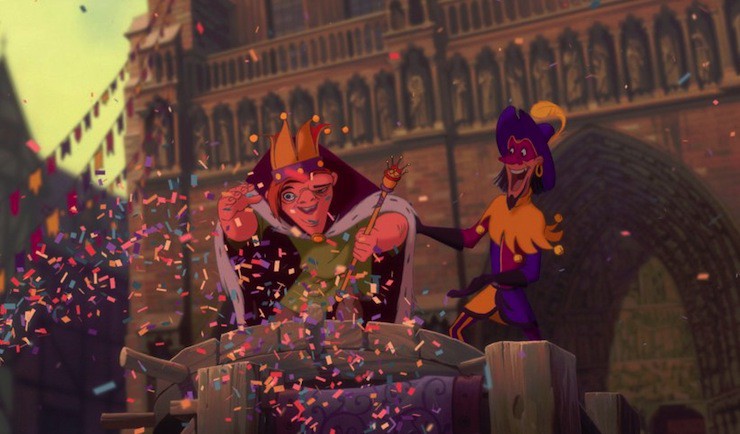
What can’t be faulted, however, is the animation. Hunchback may be the pinnacle of Disney’s hand drawn animated art, particularly during the “Hellfire” sequence, a combination of hand drawn animation and special effects that Disney never quite managed to top after this. Background artists visited Paris for inspiration and details; computer animators added the crowds and helped develop the sweeping camera movements. It looks lovely, and my frustrations with the film stem mostly from my thought that the art deserves better than the plot and voicing that it got: this could have been Disney’s greatest animated film, and yet, it isn’t.
All told, The Hunchback of Notre Dame cost about $70 million to make. It performed below expectations at the box office, bringing in just $100 million domestically and $353.2 million worldwide—more than enough to cover the film’s expenses, and far more than The Rescuers Down Under (the only box office failure of the Disney Renaissance period) but far below Aladdin and The Lion King, and even below Pocahontas, even by then considered a mild financial disappointment.
A planned direct-to-video sequel was delayed, and delayed again, all the way until 2002, when its release suggested that it probably should have been delayed still further. The then Disney-MGM Studios (now Hollywood Studios) showed a live, if shortened musical version of the film at the far, far back section of the park, which ran continuously until, probably not coincidentally, 2002. Frollo makes occasional appearances in Disney Villains products, and other Hunchback characters are sometimes featured in Disney pins (you really have to look, and for some inexplicable reason, at Walt Disney World the Hunchback pins are usually only available at, of all places, Animal Kingdom, which otherwise does not feature Hunchback merchandise or any connection to the film that I could discover. Why not in Epcot’s France pavilion next to the Ratatouille pins?) Some songs from the soundtrack—notably “The Bells of Notre Dame”—can sometimes be heard at Epcot.
Otherwise, the film disappeared from Disney merchandising.
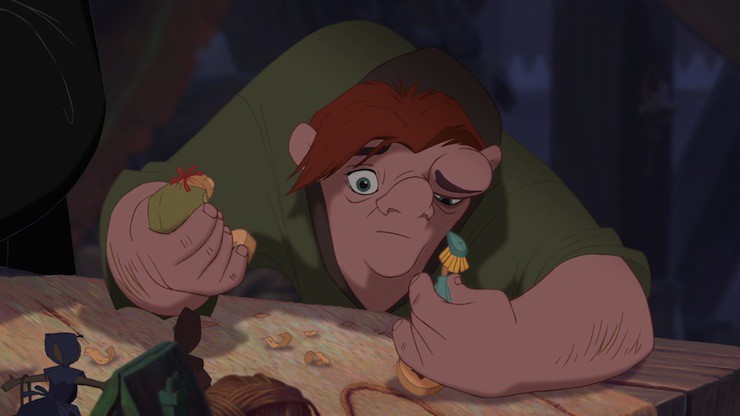
Coming right after the lukewarm response to Pocahontas, it was a severe setback to any hopes of continuing the idea of “high art” animation films, like Beauty and the Beast, Pocahontas, and Hunchback, two of which had been completely smashed at the box office by the comparatively “little,” less serious productions of Aladdin and The Lion King. Not to mention the stunning box office success of a little experimental film done by those computer guys who had helped out the Disney animators now and again—Toy Story.
It was, in a very real sense, the start of the end of the Disney Renaissance. But the Animation Studio still had a couple of high concept films in development. Oh, not the one featuring pirate ships in space, fun though that sounded. No, a little film that would be using new computer software, Deep Canvas—it would work well for showing something like, say, swinging through trees while giving a loud yell. Plus, this film for girls that had been handed over to the Florida animators—the ones originally set up to be a tourist attraction, now trusted to do their very own film about China.
But first, something silly, something that could convince audiences that Disney could be pure fun again. No, definitely not the pirate ships in space. Something more heroic.
Next up, Hercules.
Mari Ness lives in central Florida.










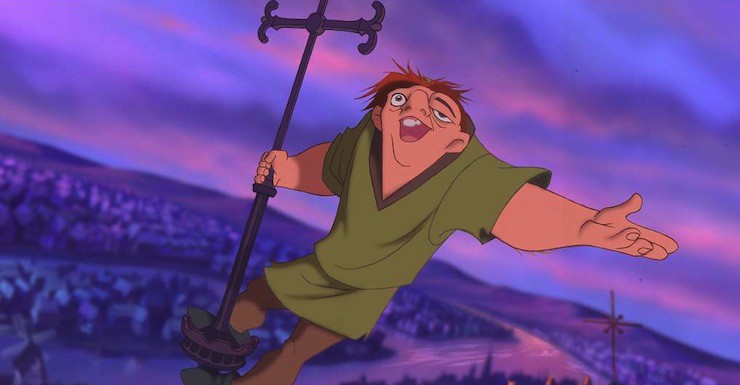
This is actually one of the only times that Disney has publicly admitted that they were wrong. An expanded staged version of the Menken/Schwartz score played for some time in Berlin (and is available, with some effort and money, as a rare import CD) and implicitly restores the tragic ending, as well as making it much clearer that the gargoyles are mental projections such that “A Guy Like You” manages to work as tragicomedy; it’s much clearer that it’s a monologue staged with four actors. An English-language adaptation just came out from Ghostlight Records, and while some plot changes were made, the tragic ending remains and indeed is made more explicit. It also eliminates the Archdeacon, restores Jehan Frollo to the story, and has Esmeralda seek shelter in a brothel rather than a farm. In the promo materials for the recording, which you can see on YouTube, there is the remarkable spectacle of Peter Schneider openly admitting that the kid-friendly story decisions in the animated version were fairly huge mistakes.
Well, it has been a long time since I saw this one, but from what I remember your write-up, Mari, is fair and on-point (as ever). It remains fond in my memory, though, for the music – not only “God Help the Outcast” (which is a magnificent song), but the score as a whole. I’m not surprised to hear @1/mutantalbinocrocodile report that the score has made it to the stage; it clearly belongs there. Clopin’s opening number is ambitious; “Hellfire” is riveting (though, as you point out, not friendly for the kiddies); and “Topsy-Turvy” must make a great, full-cast production number. Also, the orchestral underscore is just some great movie music. I wore out my cassette tape copy of this score (remember those?) in the late 90s.
The love triangle (or whatever shape it was) was a deconstruction of the Madonna/Whore Complex. As great a guy as Quasi was, he put Esmeralda on a pedestal. She was the best thing ever and she was pure and perfect. Frollo went the opposite direction and saw her a the source of his lust. Pheobus saw both sides of her, and valued the whole person.
Also the driving question was “who is the monster and who is the man?” What did Quasi and Frollo do when the did not get the girl? Frollo set the city on fire. He is the monster. Quasi accepted her decision and learned to value her as a friend. He is the man.
To me Hunchback is thematically important. Consider the upswing in American fundamentalist/evangelical Christianity in the late eighties into the nineties– it is hard not to see Hunchback as responsive to that social period. As one having experienced a bout with very deep religious fundamentalism, coming of age in the eighties, Hunchback was huge. It touched something that I fully understood, entering my psyche daring to grasp those frightening themes of judgement and hell. To see Disney boldly broaching this disturbing material was surprising.
It was also deftly handled: while the evils of abusive religion are obvious, Disney doesn’t take us away from faith, but actually invites us to take refuge (sanctuary!) within it.
I’ve rarely looked at this film as a children’s story!
The only part of this film I ever saw was a YouTube clip of “Hellfire,” and it did not seem to merit a mere G rating. *shudder* (Mind you, that was my reaction to Disney’s Hercules, for different reasons). I should watch the whole film sometime.
@1: The musical also got an English language version last year as a trial run for possibly moving to Broadway, but they chose not to make the jump. Which is a shame, because the cast album was released this year, and it’s gorgeous.
I’ve always been bothered by discussions of “did Esmeralda end up with the wrong person?” because even asking the question misses one of the main points of the movie: Esmeralda is not a prize to be awarded to the “most deserving” man, she is a person, with agency and desire of her own. That is what Quasimodo accepts, and Frollo completely refuses to. Having Quasimodo “earn” her in the end would have undercut that entire message. (As would Esmeralda dying, in my opinion, which is why that change doesn’t bother me at all in the context of the movie. It would have amounted to a fridging.)
This was my favorite Disney movie when it first came out, and it remains so to this day. Unlike Pocahontas, its adult themes (racism, misogyny, religion, public perception of disability) are given fairly nuanced treatments, and the music is absolutely fantastic. Also, much of it is so wonderfully subversive. “God Help the Outcasts” is a prime example. Esmeralda isn’t expressing faith in God, she’s challenging God to live up to the image God’s followers claim–asking why, if Jesus himself were once an outcast and if everyone is a child of God, God still lets persecution and inequality happen. Meanwhile, though she herself is not a Christian, her prayers are all for other people, whereas the prayers of the Christians around her are for themselves. It’s a gorgeous song, but there’s a lot more going on in the lyrics than people tend to remember.
And Hellfire–wow. Definitely the most daring scene Disney has ever animated, and in my view one of the best. Putting Quasimodo’s and Frollo’s contrasting reactions to their attraction to the same woman back to back was brilliant. (And the deadpan follow-up line “I had a little trouble with the fireplace” gets a belly laugh from me every time.)
It’s not the same story Victor Hugo was telling, but in my opinion, the story Disney told works. It’s a shame this movie gets so overlooked.
So, Mari, are you going to be using Action Comics #1 as the source material for Hercules? I’ve only seen the movie once, but I still distinctly remember that they turned Herc’s parents into Ma and Pa Kent.
Only saw this once in theatres. Hard to believe it’s been 20 years. Dark as it is, I still enjoyed it, especially the animation.
I sum up Quasimodo’s character arc as “You can’t always get what you want, but if you try sometimes, you just might find that you get what you need.” He doesn’t get the girl. (The girl doesn’t get gotten at all. She chooses a guy she likes and is attracted to.) But he does get to break out of his assigned role as the mysterious monster in the tower. Practically the last time we see him, he’s standing outside the walls of Notre Dame, and people are talking to him. Just talking. Not mocking, not screaming.
@2 I agree, the most memorable part of this movie is the music. “The Bells of Notre Dame” is a great bookender for the movie, and, of course, “Hellfire” is probably one of the best Disney songs ever. (“Hellfire” quotes “Bells” if I remember correctly.)
Mutantalbinocrocodile – Thanks for that; I’ve never encountered the musical. I definitely think “A Guy Like You” would work much better as a clear hallucinatory sequence, rather than as it is in the film: possibly a hallucination, possibly not, and unquestionably happening at the completely wrong time.
MikePoteet – The music and the art deserved fewer gargoyles.
AyeJaeSedai – That’s a fascinating reading of the film, and it’s not completely wrong – but it’s also a little bit at odds with the film, which more than once does seem to be making the argument that Quasimodo should get the girl. even as it also admits that this is her choice, and shows Quasimodo accepting that.
M – I don’t think I’d classify the film as a children’s story either (and the novel definitely isn’t) but that is how Disney originally marketed it, right down to the Burger King campaign with the little gargoyle toys. My sense is that marketing hurt the box office take – some adults who might have loved it avoided it because they thought it was a kiddie movie. Meanwhile, since this is really not a film for small children, the box office take probably also took a hit from that.
SKM – As I noted in the post, I think one of the stronger points of this film is that it does accept that Esmeralda has the right to make her own choices, even if its main villains disagrees. So I don’t think I did miss that point in the movie.
The film itself, though, spends considerable time asking that question, so I think it’s fair for viewers to discuss it.
Sean Burcher – Frankly, the sheer amount of Herakles/Hercules material is a bit overwhelming, and that’s before mentioning comics. We’ll see what ends up in the final post.
Jenny Islander – Yeah – his ability to accept that Esmeralda is in love with someone else is what gains Quasimodo something else he needs and wants: two friends. In contrast to Frollo, who can’t accept that, and thus loses everything.
This is not one of the Disney movies I’ve seen more than once. My strongest memory is the gargoyles spitting off the tower at the people below. I can’t even remember what the sequel was about but I did watch it.
@robinm I never watched the sequel, but I’m like 99% sure it was about giving Quasi a girlfriend.
This was my favorite film when I was a young teen. The art and music were of course beautiful, but I think it really landed with me because there was a rather enuthusiastic fandom around it (a good percentage of which were adults), and I made lots of internet friends there. We even had our own gathering at WDW and met up with the actors of the stage show. Clopin being the most fun of those actors, because he was also a “park character” and interacted with guests. Because Clopin came from a more “adult” movie with more “adult” themes, his park character got away with making tons of “flew over the heads of babes” jokes that their parents loved.
Always hated the gargoyles. They were so completely off-key in their timing and jokes. Some comedic characters are great (Genie & Abu, the sidekicks in BatB, Meeko & Percy, etc.), but others are just terrible (Lookin’ at you, Treasure Planet. Sheesh.)
MariCats, the only difficulty is that the only recording of “A Guy Like You” that is a discordant hallucination with three mental projections insisting to Quasimodo’s conscious self that he counts as handsome. . .is in German. Cut for the English-language version (though the replacement “Flight Into Egypt” plays even further into AyeJaeSedai’s Virgin/Whore reading, more than implying that Quasimodo is imaging Esmeralda as Mary and himself as Joseph in a Josephite relationship).
As @6 mentions, the English cast album is gorgeous. But unfortunately. . .I do think the German import album is more gorgeous on the whole. There is some extraordinary music writing here, and there are ways to get that without the jarring bad tonal judgments.
Tony Jay made this movie. Wonderful voice actor, he is very much missed.
I barely remember this movie from the one time I saw it. Some great animation, some great songs, some interesting characters, but in the end, I just didn’t think it fit well together, like it didn’t really know what it wanted to be. And a lot of focus on sex and obsession, which didn’t feel like it belonged in a Disney cartoon.
Mari,
I don’t know if you are much of a gamer, but even if you’re not, you owe it to yourself to play the Kingdom Hearts video games. A a lifelong Disney fan, there is something special about moving through and interacting with three dimensional versions of the Disney movie worlds, battling on Pride Rock and playing mini games in the Hundred Acre Wood. In the La Cite des Cloches level of Kingdom Hearts 3D: Dream Drop Distance you can climb Notre Dame inside and out and explore the streets of Paris and the Court of Miracles. I’m not crazy about this movie, but the level is absolutely gorgeous.
The mythology is insanely dense and complicated, but the games really are worth checking out
The Mexican crooner, Luis Miguel, recorded one of the songs from this movie under the title “Suena,” which I think means “Dream” — I don’t know what it is in English, but it’s a lovely song. Never saw the movie, but now I’d really like to get the cast album.
I’ve sometimes called this one of the worst movies with some of the best music in the Disney lineup. It’s such an amazing score, and the opening sequence and “God Help the Outcast” always give me chills.
The opening song also gave me an inspiration for a writeup I’m planning to do for Beauty and the Beast. “Who is the monster and who is the man?/What makes a monster and what makes a man?” is really perfect for analyzing the insertion of Gaston as a villain in addition to the actual Beast. (Also, I only know of one adaptation of Beauty and the Beast that doesn’t change him back into a human – “The Fire Rose” by Mercedes Lackey, one of her elemental masters series, and it’s more of a werewolf spell that is out of control.)
I definitely think the film is improved by assuming the gargoyles are not real outside of Quasimodo’s mind.
I just still can’t believe the goat is one of the most accurate portrayals from the book!
@brenda A. no. 20: One of Robin McKinley’s two retellings ends with the Beast being set free, but still in Beastly form.
Agree with folks on the excellence of the music; this is the only Disney movie whose soundtrack I have on CD. Too bad the English musical version didn’t fly (even if it wasn’t quite as good as the German version).
Agree with Mari et al. that the music and the animation deserved a story that settled on an audience as adult as the music, rather than flipping wildly back and forth between G and (at least) PG-13.
One random comment on Quasi’s toys: one of the Uncle Scrooge comic-book stories by the great Carl Barks (creator of Uncle Scrooge and many associated characters) is titled “The Phantom of Notre Duck.” The Phantom lives in Duckburg’s Notre Duck Cathedral, and he has been stealing the coins thrown into its fountain in order to use them to build a small replica of the cathedral. I do wonder whether Quasi’s miniature cathedral was inspired by the one in Notre Duck.
Angela Carter’s The Bloody Chamber has two versions of Beauty and the Beast — in the looser telling, “The Tiger’s Bride”, it’s Beauty who does the transforming. The other, “The Courtship of Mr. Lyon”, has the traditional transformation but suggests either that it’s subjective, or that the human Beast is still reminiscent of his leonine form.
@19 “Suena” is the 3rd person present form of the verb “sonar”, meaning “sound”. It’s frequently used together with como (“like”) to say that something sounds like something else. The word for “dream” is “sueño.”
WRT the book, though I have to say, it’s a bit surprising to see such religious cynicism on display by the author of Les Miserables. Strip away all the massive, wandering digressions, and at its core you have a story about how faith in God can transform even a wretched, depressed, misanthropic criminal into a paragon of virtue who blesses the lives of everyone around him. (Except, of course, Javert, whose fanaticism prevented him from ever developing mature, well-rounded faith, leaving him so distorted that he’s literally incapable of recognizing goodness when it stands before him.) That’s a very different perspective than is found in Notre-Dame de Paris!
@10/Phillip – Yes, I think so – quoted in a minor key, right? Good catch!
@6/SKM – I agree with your take on the song. I have also successfully used the song in church education settings as a call for people of faith to take what they say they believe more seriously.
20. Brenda A.
Tanith Lee also has a short story where the ‘Beast’ doesn’t transform at the end. It’s in her Red as Blood collection and is called Beauty.
I wonder what would be different about this film if they made it today. Hunchback is a GREAT story, and lends itself well to animation, just not kid-friendly animation. If Disney was able to make a PG-13 version of this film, where the director and animators could focus on telling the story they way they wanted to, I think it would be great.
@25 This actually does not connect with my memories of Les Miserables in the novel form. I distinctly remember Victor Hugo’s epic, chapter-long rants on how faith is fine but religion is oppressive and terrible. (I counted the pages of the one attached to the convent with the nun who’d never lied in her life and then did so flawlessly to save Valjean: in my copy, it was 42 pages of small print about what a god-awful thing religion was and how oppressive.) I’d always associated Javert with dogma and Valjean with actual faith from those books. And there was no way Javert was the hero, except in his own mind and when he realized he wasn’t, he committed suicide.
@mari: I would like to commend you for your attention to the goat, in both the written and movie forms. I APPROVE. (The goat was the only character I liked.)
Everyone – on a completely self serving note, I’d just like to point out that in my own Beauty and the Beast retelling, the Beast is not transformed back into a human.
To get back to Hugo and the discussions of Les Miserables for a moment – yeah, I’d have to agree with Bayushi on this one. The musical has some lovely inspiring quasi-religious songs. The novel does have the one saintly bishop at the beginning, but after that, I found myself wondering if some priests had kicked Victor Hugo’s puppy.
Regarding Kingdom Hearts – I’ve tried, but attempting to play the game left me with a severe migraine. I like the screenshots I’ve seen though.
Thebobquaz – On the one hand, part of me wants to see Disney do a new version of this film with the same music but different voices and at most limited gargoyles. On the other hand, Disney seems to have abandoned hand drawn animated films (at least, from what John Lasseter is saying right now), and while quite a lot of their computer animated work is genuinely beautiful, I think I would constantly be comparing it – negatively – to the hand drawn animation of this film.
I really love this movie. First, I think the animation and music are just gorgeous. Second, I was just the right age when it came out to be ready to appreciate some darker themes. I’m happily religious but I can still appreciate a movie that points out the evils of hypocrisy, lust, concern only for self/status, etc. Hellfire is probably one of my favorite Disney sequences ever – it’s ostensibly a prayer to Mary/the saints/God, but quite quickly it’s apparent (if it wasn’t already) that Frollo is basically the Pharisee who prays ‘thank God that I’m not like this other guy over here’…and then spirals into something darker entirely.
“But nothing, except arguably Tony Jay as Frollo, particularly stands out, either, and most of the voicing” – no ‘arguably’ about it, I think!
God Help the Outcasts is also one of my favorite Disney songs.
Also, I always got a good giggle out of Frollo’s alphabet. “D. Damnmation. E. <I>Eternal</I> damnation.”
Regarding the ‘love’ story, I also agree that the important thing in this story IS that Esmeralda gets to choose, and isn’t punished for it, or for not choosing the main character. I think there are some problematic aspects in that the person she chooses is of course the good looking able bodied one, though.
I was always of the ‘gargoyles are Quasimodo’s imgainary friends’ school of thought, and that’s what makes A Guy Like You somewhat tragicomic and poignant, at least to somebody who often had her own fantasies of that type that never came to fruition – but still had to move on and get on with her life.
This might be of interest. Someone is conducting a survey on adult perceptions of Disney films: https://leeds.onlinesurveys.ac.uk/disney-survey.
Thanks, 32. Jake N for the link!
For me, when this film came out, I thought it was gorgeous, but I never connected with any of the human characters. In fact, the only reason I ended up liking the film was because of the goat. So much so, that I actually bought ALL the goat merch! I still have the backpack and the stuffed toy with BELLS in his hooves!
@19/starrise – The English version is “Someday”, which is sung over the ending credits of the movie. According to Wikipedia, it was originally written for Esmeralda to sing at about the point where she sings “God Bless the Outcasts” in the final cut.
@20/Brenda A. – Ursula Vernon is another author who’s done a Beauty and the Beast retelling where the heroine gets to keep the beast she fell in love with at the end.
@29/Bayushi – I’m not sure where your point of disagreement with Mason Wheeler is? You’re both saying that Valjean has faith and that Javert is doomed because he has rigid dogma instead.
General remark – Some years ago, Paul McAuley and Kim Newman did a presentation at the Hugo Awards ceremony reporting from an alternate timeline where the awards were named in honour of Fiction-Scientifique pioneer Victor Hugo, author of (inter alia) the young adult adventure “The Jetpack of Notre Dame”. I mention this mainly to point out that their synopsis of that work, though brief, takes the time to mention that even in that universe the goat is still one of the most important characters.
First off, fantastic review. 10 out of 10. I did not grow up with this movie as a child, however I distinctly remember seeing VHS commercials for the sequel ( awful, I think nowadays from what ive gleamed from it). I forts watched it back in 2011 on DVD, and I remember being grabbed by the music already back then. Over the years I since come to understand the maturity and darkness of the film. And after rewatching the film last year, I can safely say this:
awful, I think nowadays from what ive gleamed from it). I forts watched it back in 2011 on DVD, and I remember being grabbed by the music already back then. Over the years I since come to understand the maturity and darkness of the film. And after rewatching the film last year, I can safely say this:
Not only is Disney’s THOND my favorite Disney movie…
Not only is it superior to The Lion King and Beauty and the Beast…
BUT it is also, whether intended or not, one of the pioneers of ADULT animation in the West. Yes, you heard that right. This is not a ”kids movie”, good or bad. This is not a family movie, though that was probably Disney’s intention and what it was marketed as. It is a Gothic (as in Gothic Horror and fiction) historical adventure musical drama, a respectful adaption of Victor Hugo’s novel, with slight elements meant for children, which does NOT detract from the story (Yes, I mean the gargoyles, Yes I like them, they’re alive, the whole CHURCH is sentient), beautifully darkly animated, and worthy of being compared with works such as Gargoyles, Batman TAS, Xmen TAS, and even HBO:s SPAWN. SEE. IT.